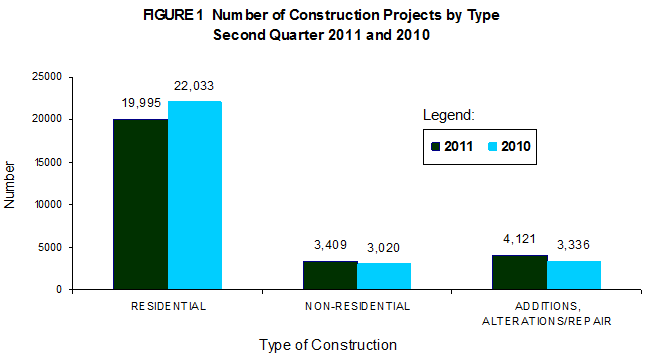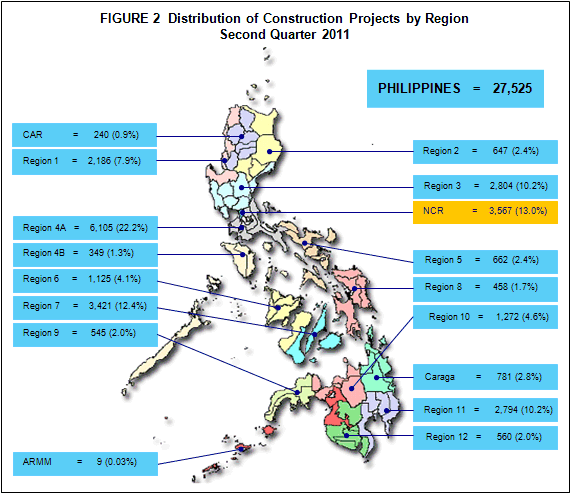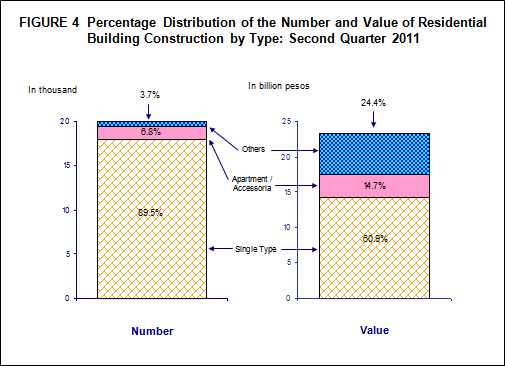New construction projects post 27,525 in the second quarter
-
The new construction projects from approved building permits nationwide totaled to 27,525 during the second quarter of 2011, representing a decrease of 3.0 percent compared with 28,389 construction projects registered over the same period in 2010.
-
Residential type building construction during the second quarter of 2011 recorded a total of 19,995, down by 9.2 percent from last year�s total residential construction of 22,033. On the other hand, non-residential construction for the period grew 12.9 percent to 3,409 from 3,020 during the same quarter of 2010.
-
Approved applications for additions, alterations and repairs of existing structures with a combined total of 4,121 increased by 23.5 percent from 3,336 approved applications recorded during the same quarter of 2010. Figure 1 compares the number of approved building permits by type of construction for the second quarters of 2010 and 2011.

-
At the regional level, number of construction projects in CALABARZON (Region IVA) remained highest at 6,105, accounting for 22.2 percent of the total. National Capital Region (NCR) and Central Visayas (Region VII) occupied second and third spots with shares of 13.0 percent (3,567) and 12.4 percent (3,421), respectively, in terms of number of constructions. Central Luzon (Region III) ranked fourth with 2,804 constructions and Davao Region (Region XI), ranked fifth with 2,794.
-
For areas outside NCR, seven (7) provinces contributed the biggest number of construction projects exceeding a thousand mark during the second quarter 2011. These were Cavite (2,193 or 8.0%), Davao del Sur (1,901 or 6.9%), Cebu (1,733 or 6.3%), Rizal (1,137 or 4.1%), Batangas (1,116 or 4.1%), Laguna (1,108 or 4.0%) and Bohol (1,015 or 3.7%). Figure 2 displays the distribution of construction projects by region.

Value of construction projects reaches PHP55.7 billion
-
Aggregate value of construction projects during the second quarter of 2011 increased 13.4 percent to PHP55.7 billion from PHP49.1 billion posted during the same quarter of 2010.
-
Value of construction for residential type building exhibited a decrease of 7.9 percent to PHP23.3 billion from PHP25.2 billion during the same quarter of 2010.
-
However, value for non-residential building construction, significantly went up by 36.9 percent to PHP27.9 billion from PHP20.4 billion registered during the same period of 2010.
-
Moreover, combined value of construction for additions, alterations and repairs of existing structures, estimated at PHP4.5 billion, rose 30.4 percent from PHP3.4 billion registered during the same period of 2010. Figure 3 compares the aggregate value of construction by type of building for the second quarters of 2010 and 2011.

-
Across the country, value of construction for the NCR remained highest at PHP25.2 billion, accounting for 45.2 percent share of the total value. Region IVA and Region VII ranked a far second and third with respective shares of 13.8 percent (PHP7.7 billion) and 12.0 percent (PHP6.7 billion).
Average cost per square meter of residential building construction is PHP8,126
-
Total value of construction for residential buildings was PHP23.3 billion with a total floor area of 2.9 million square meters, translating to an average cost of PHP8,126 per square meter. This figure represents a slight decrease of 3.1 percent compared with the average cost of PHP8,384 per square meter of the previous year.
-
Among the residential construction, single type recorded the most number of projects with 17,898 (89.5%). Total value of construction for this type reached PHP14.2 billion covering a total floor area of 1.8 million square meters translating to an average cost of PHP7,789 per square meter.
-
Apartment/accessoria followed next with 1,358 construction projects representing 6.8 percent of total residential construction. This type of residential building construction had an estimated construction value of PHP3.4 billion with total floor area of 477.0 thousand square meters or an average cost of PHP7,186 per square meter.
-
Duplex type residential building recorded a total of 639 construction projects or 3.2 percent of the total residential construction. Total value for this type amounted to PHP662.7 million and a total floor area of 99.4 thousand square meters or an average cost of PHP6,668 per square meter. Figure 4 displays the percentage distribution of the number and value of residential building construction by type for the second quarter of 2011.

Commercial type marks an average cost of PHP14,377 per square meter
-
The total value of non-residential building construction reached PHP27.9 billion with a total floor area of 2.3 million square meters. This translates to an average cost of PHP12,394 per square meter.
-
Commercial type dominated all other types of non-residential building construction with 2,085 projects (61.2%). Value of construction for this type was estimated at PHP20.5 billion covering a total floor area of 1.4 million square meters or an average cost of PHP14,377 per square meter.
-
Institutional building construction ranked a far second with 526 construction projects (15.4%), construction value of PHP3.9 billion and a total floor area of 331.6 thousand square meters or an average cost of PHP11,745 per square meter.
-
This was followed by industrial type building construction with 385 construction projects (11.3%). The total value of industrial construction amounted to PHP3.0 billion with a total floor area of 409.6 thousand square meters. This registered to an average cost of PHP7,434 per square meter.
-
The least number of non-residential construction was reported for agricultural type building with 144 or 4.2 percent of the total. Construction value was estimated at PHP299.9 million covering a total floor area of 87.9 thousand square meters, expressing to an average cost of PHP3,413 per square meter. Figure 5 shows the number and value of non-residential building construction by type for the second quarter of 2011.

TECHNICAL NOTES
Scope and Coverage
Private construction statistics from approved building permits relate to data on new constructions and additions, alterations and repairs of existing residential and non-residential buildings and other structures undertaken in all cities/municipalities of the country.
For this publication, data for the provinces of Maguindanao (excluding Cotabato City), Masbate, Misamis Occidental, Sulu, Tawi-tawi and Zambales are not included in the tabulation as these provinces did not submit building permit documents and/or certification of no construction before the deadline. However, if any, these are to be included in the annual tabulation.
Source of Information
Construction statistics are compiled by the National Statistics Office (NSO) from the copies of original application forms of approved building permits as well as from the demolition permits collected every month by NSO field personnel from the Offices of Local Building Officials (LBOs) nationwide.
Limitations:
-
Data on private building constructions refer to those proposed to be constructed during the reference period and not to construction work completed during the reference period.
-
The completeness of the number of building permits collected relies on the approval of applications filed with the Office of Local Building Officials (LBOs). Hence, private building constructions without approved building permits are excluded from the tabulation of data.
Geographic Classification
Private building constructions are classified and presented by geographic area using the Philippine Standard Geographic Classification (PSGC). The PSGC contains the latest updates on the official number of regions, provinces, cities, municipalities and barangays in the Philippines. It consists of 17 administrative regions as approved under Executive Order No. 36 dated 19 September 2001 (Providing for the Reorganization of the Administrative Regions in Mindanao) and Executive Order No. 103 dated 17 May 2002 (Dividing Region IV into Region IV-A and Region IV-B, transferring the province of Aurora to Region III).
The geographic codes are in accordance with NSCB Resolution No. 3, Series of 2005 that approved the PSGC.
Industry Classification
Private building construction statistics utilizes the amended 1994 Philippine Standard Industrial Classification (PSIC) to classify the main activity through the use or type of occupancy of the building.
Definition of Terms:
Building permit is a written authorization granted by the Local Building Official (LBO) to an applicant allowing him to proceed with the construction of a specific project after plans, specifications and other pertinent documents have been found to be in conformity with the National Building Code (PD 1096).
Building refers to any independent, free-standing structure comprised of one or more rooms or other spaces, covered by a roof and enclosed with external walls or dividing walls, which extend from the foundation to the roof.
Construction refers to an all on-site work done from site preparation, excavation, foundation, assembly of all the components and installation of utilities and equipment of buildings/structures.
Residential building is a building for which its major parts or more than half of its gross floor area is built for dwelling purposes. This type of building can be of the single type, duplex, an apartment and/or accessoria and residential condominium.
Single house is a complete structure intended for a single family or household, i.e. bungalow, 2-storey house, nipa hut.
Duplex is a structure intended for two households, with complete living facilities for each; it is a single structure divided into two dwelling units by a wall extending from the floor to the ceiling.
Apartment is a structure, usually of two storeys, made up of independent living quarters, with independent entrances from internal walls and courts.
Accesoria is a one or two-floor structure divided into several dwelling units, each dwelling unit having its own separate entrance from the outside.
Residential condominium is a structure, usually of several storeys, consisting of multiple dwelling units.
Other residential constructions consist of school or company staff houses, living quarters for drivers and maids and guardhouses.
Non-residential building includes these type commercial, industrial, agricultural and institutional buildings.
Commercial buildings refer to office buildings and all buildings which are intended for use primarily in wholesale, retail and service trades; i.e. stores, hotels, restaurants, banks, disco houses, etc.
Industrial buildings are all buildings used to house the production, assembly and warehousing activities of industrial establishments; i.e. factories, plants, mills, repair shops, machine shops, printing press, storage plant, electric generating plants.
Institutional buildings are buildings which primarily engaged in providing educational instructions and hospital/health care; ports, airports and other government buildings; i.e. school, museums, libraries, sanitaria, churches, hospitals.
Agricultural buildings are buildings used to house livestocks, plants and agricultural products such as barn, poultry house, piggeries, stables, greenhouses and grain mill.
Other non buildings constructions include cemetery structures, street furniture, waiting sheds, communication towers, etc.
Addition refers to any new construction which increases the height or area of an existing building/structure.
Alteration is a construction in a building/structure involving changes in the materials used, partitioning and location/size of openings, structural parts, existing utilities and equipment but does not increase the overall area thereof.
Repair is a remedial work done on any damaged or deteriorated portion/s of a building/structure to restore its original condition.
Demolitions refer to the systematic dismantling or destruction of a building/structure or in part.
Street furniture are street structures consisting of monuments, waiting sheds, benches, plant boxes, lampposts, electric poles and telephone poles.
Floor area of building refers to the sum of the area of each floor of the building measured to the outer surface of the outer walls including the area of lobbies, cellars, elevator shafts and all communal spaces in multi-dwellings. Areas of balconies are excluded.
Total value of construction refers to the sum of the cost of building, electrical, mechanical, plumbing, and others. The value is derived from the approved building permit and represents the estimated value of the building or structure when completed.
Unpublished Data: Unpublished data at the municipal level may also be made available upon request from the Industry Statistics Division, National Statistics Office, 4th Floor Solicarel II, Ramon Magsaysay Blvd. Sta. Mesa, Manila, and Tel no. 716-39-32.
Source: National Statistics Office
Manila, Philippines
